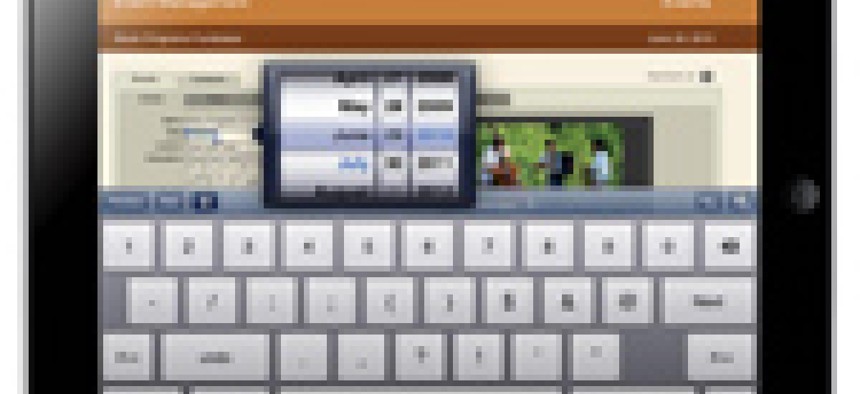FileMaker Go brings databases to iPad, iPhone


Connecting state and local government leaders
Although you need to have Filemaker Pro on a separate system, the FileMaker Go iPad application takes advantage of that device's ease of use.
More feds are testing the waters and adopting iPhones and iPads. But although usability and pure sleekness are off the scale with both of those devices, there is a dearth of meaty business applications when compared to those built for some other mobile platforms. FileMaker is attempting to change that with the release of FileMaker Go, which gives users a way to view and change enterprise databases on the fly — and on the road.
We tested the iPad version of the new software, which was easy to download from the Apple iTunes store. The iPad version we tested costs $40. A version that runs on an iPhone is $20.
The first thing you should know about FileMaker Go is that it needs to link to a PC with a full version of FileMaker Pro or connect to a FileMaker Server. The mobile application can’t create a new database on its own, though it can do just about everything else, including creating new records for existing databases.
FileMaker Go
Pros: Provides a lot of the tools desktop product does; also uses iPad’s features.
Cons: Can’t start a new database without linking to a computer running FileMaker Pro.
Performance: A
Ease of use: A-
Features: C+
Value: B+
Price: $40 for iPad version; $20 for iPhone version.
So FileMaker Go would be a good program to extend your FileMaker database reach but terrible as a first step to bringing FileMaker into your agency. My guess is that there is no technical reason why FileMaker Go couldn’t create new databasess. It was probably removed as a function because people might just buy the $39 application and skip the more expensive Pro installation if they could. With this setup, Pro is a necessary component.
There are some other things that Go can’t do. You can’t modify tables or fields or the relationships setup within the core database. And you can’t print or even spell-check database fields.
But what FileMaker Go can do, it does quite well. If you have an existing FileMaker database, you can bring it over to your iPad. From that point on, you can browse the existing records or add new ones.
Say you have a database of notable flora inside a national park. A ranger could take an iPad into the field and make entries for new flowers. Entering new records is easy and portable because of the iPad platform. Inventory management comes to mind as an extremely useful way to make use of FileMaker Go. Assuming you don’t need to add any new fields, which is another restriction, Go would work just fine.
I suppose one could suggest that FileMaker Go's restrictions make it more secure. People can add new records but can’t change the existing database, mess up formulas or delete important fields. That makes it a notable tool for workers and less of a worry for database administrators.
Once synced, transferring files from a PC to the iPad is simple. In fact, it was pretty much like moving any other files. You simply go to the FileMaker Go transfer menu and browse until you find the database you need. Then you click to bring a file over or add new records that you created back to the main database.
The ease of use of Go comes from the iPad. Although I don’t want to get into another review of the iPad for feds, which Carlos Soto covered quite thoroughly, it’s easy to confirm that ease of use is the iPad’s middle name, or perhaps even its first name. The large screen means that pictures inserted into the database look great. And the pop-up keyboard makes typing data into Go’s fields easy and even a little fun. Throw in the fact that the iPad will orient itself to whatever direction you are facing, and you’ve got a winner for a database entry tool.
One potential problem an agency might face is that the iPad does not support every font, though most of the more popular ones are. The iPhone version of Go supports only Arial, Courier, Courier New, Georgia, Helvetica, Times New Roman, Trebuchet MS, Verdana and Cochin. The iPad version we tested supported all those plus Academy Engraved LET, Baskerville, Chalkduster, Optima, Palatino, Gill Sans, Futura, Cochin, Snell RoundHand and Didot.
In addition, the overall design of the database display should be compatible with the iPad, if not the iPhone. In the case of the iPad, overly large displays can be moved so that all the data can be seen, but why put your mobile users through the extra steps if you don’t need to? That might be an additional consideration to bringing Go into your organization. Although all future databases could be created to be 100 percent compatible, you might have some existing databases that aren’t easily converted.
How much you get out of FileMaker Go depends on how much you use FileMaker as your database of choice. If you already have FileMaker databases, this is a wonderful tool to get you up and out of the office. It could even become essential if employees need access to a database in the field. However, with all the restrictions, the most painful being the inability to create a new database, those who have not yet started using FileMaker shouldn’t start here.
Basically, if you have the FileMaker square pegs anyway, this will fit right in. If you have the round holes of some other database program, Go won’t do you any good.
FileMaker, www.filemaker.com
NEXT STORY: Footprint? This desktop PC has a toeprint




